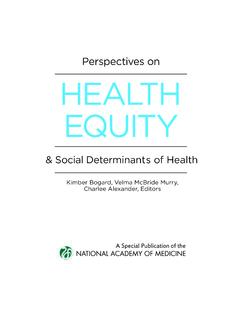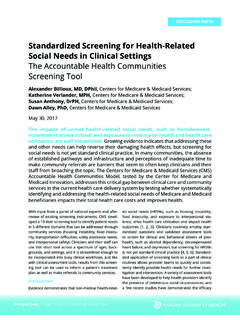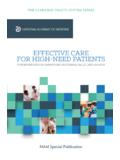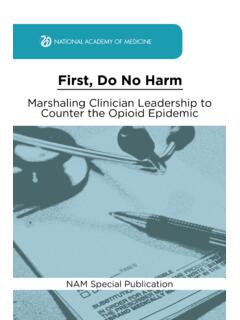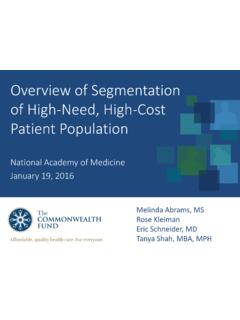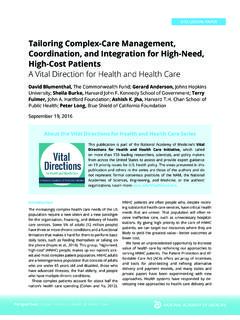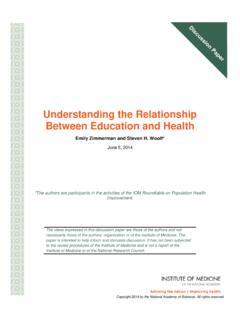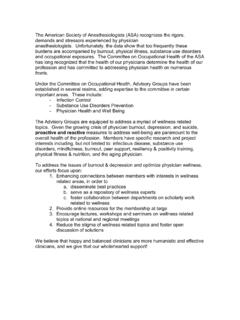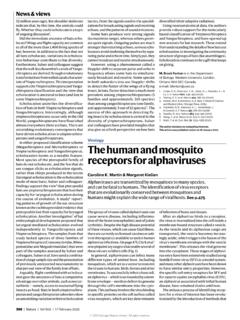Transcription of Health Inequities, Social Determinants, and Intersectionality
1 Health Inequities, Social Determinants, and IntersectionalityNancy L pez, PhD, University of New Mexico; Vivian L. Gadsden, EdD, University of PennsylvaniaDecember 5, 2016 ABSTRACT | In this essay, we focus on the potential and promise that Intersectionality holds as a lens for studying the Social determinants of Health , reducing Health disparities, and promoting Health equity and Social justice. Research that engages Intersectionality as a guiding conceptual, methodological, and praxis-oriented framework is focused on power dynamics, specifically the re-lationships between oppression and privilege that are intrinsic to societal practices. Intersectional knowledge projects aimed at studying this interplay within and across systems challenge the status quo.
2 Whether reframing existing conceptualizations of power, implementing empirical research studies or working with community organi-zations and global Social movements, intersectional inquiry and praxis are designed to excavate the ways in which a person s multiple identities and Social positions are embedded within systems of inequality. Intersectionality also is attentive to the need to link individual, institutional, and structural levels of power in a given sociohistori-cal context for advancing Health equity and Social justice. DISCUSSION PAPERP erspectives | Expert Voices in Health & Health Care Health Disparities, Inequity, and Social Determinants: A Brief ContextThe urgency to promote Health , reduce Health dispari-ties, and address the Social determinants of Health is highlighted in countless reports (World Health Orga-nization, 2006, 2015; Hankivsky and Christoffersen, 2008).
3 In short, problems in Health disrupt the human developmental process. They undermine the qual-ity of life and opportunities for children, youth, and families, particularly those exposed to vulnerable cir-cumstances. Despite incremental change within and across Health -serving agencies and increased Health education and scrutiny of patient care, we continue to see significant disparities in the quality of Health and life options that children in racial and ethnic minority, low-income homes and neighborhoods experience (Bloche, 2001). Research has uncovered several inter-connections between Health and environmental and Social factors (Chapman and Berggren, 2005; Thorpe and Kelley-Moore, 2013), but has not always shifted paradigms sufficiently to either disentangle intersect-ing inequalities or tease apart the ways in which Social factors and structural barriers at once interlock to pre-vent meaningful and sustainable this essay, we focus on the potential and promise that Intersectionality holds as a lens for studying the Social determinants of Health , reducing Health dispari-ties, and promoting Health equity and Social justice.
4 Collins and Blige (2016) describe Intersectionality asIntersectionality is a way of understanding and analyzing complexity in the world, in people, and in human experiences. The events and conditions of Social and political life and the self can seldom be understood as shaped by one factor. They are shaped by many factors in diverse and mutually influencing ways. When it comes to Social inequality, people s lives and the organization of power in a given society are better understood as being shaped not by a single axis of Social division, be it race or gender or class, but by many axes that work together and influence each DISCUSSION PAPERPage 2 Published December 5, 2016 other.
5 Intersectionality as an analytic tool gives people better access to the complexity of the world and of use Intersectionality as an analytic tool to solve problems that they or others around them face. (p. 2)We ask: How do we engage in inquiry and praxis (ac-tion and reflection) that departs from the understand-ing that intersecting systems of oppression, including race/ structural racism, class/capitalism, ethnicity/eth-nocentrism, color/colorism, sex and gender/patriar-chy, and sexual orientation/heterosexism, nationality and citizenship/nativism, disability/ableism and other systemic oppressions intersect and interact to produce major differences in embodied, lived race-gender that shape the Social determinants of Health ?
6 How can we as scholars, researchers, and practitioners concerned with child and family well-being take seriously the re-ality of intersecting systems of power intersecting to produce lived race-gender-class and other Social loca-tions of disadvantage and develop an Intersectionality Health equity lens for advancing Health equity inquiry, knowledge projects and praxis?We argue that the potential power of intersectional-ity as a transformational paradigm lies in two domains relevant to understanding Social determinants. First, it is a critical knowledge project that questions the sta-tus quo and raises questions about the meaning and relationship between different Social categories and intersecting systems of privilege and oppression (Col-lins, 2008, 2015; Collins & Bilge, 2016; Bowleg, 2008; Yuval-Davis, 2011).
7 It also pushes against the idea of blaming the victim that is, the simplicity of explain-ing Health or educational outcomes by attributing problems to individuals genetics or cultural and Social behaviors alone. Second, by focusing on power rela-tions at the individual, institutional and global levels and the convergence of experiences in a given socio-historical context and situational landscape, it serves as an anchor to advance equity and Social justice aims for marginalized communities that have experienced and continue to experience structural inequalities (Crenshaw, 1993; Collins, 2008, 2009, 2015; Weber, 2010). In both instances, researchers and practitioners cross traditional academic, sectoral and disciplinary boundaries to reconceptualize a problem and com-bine methods from different disciplines ( , in inter-disciplinary research), or they apply conceptualizations and methods from one discipline to closely examine issues in another ( , in transdisciplinary research, epistemologies and methodologies).
8 There is growing evidence and professional wisdom to suggest that Health disparities do not exist in iso-lation, but are part of a reciprocal and complex web of problems associated with inequality and inequity in education, housing, and employment (Schultz and Mullings, 2006; Weber, 2010; LaVeist and Isaac, 2013; Williams and Mohammed, 2013). These disparities af-fect the unborn child through Social -emotional chal-lenges such as maternal stress and diagnosed and undiagnosed medical problems, including higher prev-alence of gestational and preexisting diabetes in some pregnant populations. In other cases, they are observ-able at birth, particularly pronounced when prenatal care is unavailable, when the importance of care is not understood fully, and when young children are not ex-posed to the cognitive and Social -emotional stimula-tion needed to thrive.
9 These and other problems are manifested in parental stress, for example, in mother-headed and two-parent, low-income, and immigrant households alike. Parent and family adversity may reduce the number and quality of resources available and life experiences for children and families in the early years and throughout the life course. Such ad-versity is exacerbated by structural barriers that limit employment opportunities, increase housing instabil-ity, and contribute to homelessness, and that constrain efforts by families to effect positive the past 20 years, two major shifts in discus-sions of Health disparities and inequity have spurred interest and research.
10 One shift is the growth in and opportunities presented by interdisciplinary and trans-disciplinary research ( , work extending from sociol-ogy and psychology to economics, among other fields) and cross-domain practice ( , medicine, education, and Social work) (see LaVeist and Isaac, 2013; Gadsden et al., 2015b). The reach of interests in these issues can be found not only in the Social and medical sciences but also in contemporary ethical, moral and political philosophy, such as Sen s (2009) linking of Health eq-uity and agency, and his commentaries on the implica-tions for Social justice (Sen, , 2009). A second shift has been the heightened attention to Health determi-nants, more frequently called Social determinants of Health instead of a biomedical model that solely fo-cuses on the individual level make-up and behaviors of patients as the source of Health disparity.

